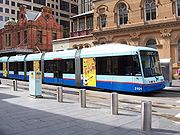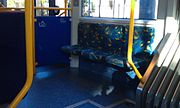- Metro Light Rail
-
For the light rail system operating in Houston, Texas, United States, see METRORail. For the light rail system operating in Phoenix, Arizona, United States, see METRO Light Rail (Phoenix).
Metro Light Rail 

Mode Light rail Owner Metro Transport Sydney Operator(s) Veolia Connects Central (interchange)
Convention (interchange)
LilyfieldLength 7.2 km (4.5 mi) Stations 14 Patronage 3.5 million (annual) Key dates 1997 Opened to Wentworth Park 2000 Extended to Lilyfield The Metro Light Rail (formerly the Sydney Light Rail) is the only currently operating light rail line in Sydney. The line opened on 31 August 1997,[1] mostly along the route of an unused goods railway line, to serve the redeveloped inner-city areas of Darling Harbour, Ultimo and Pyrmont, and was extended in 2000 to serve some of Sydney's inner western suburbs.
Contents
Central to Lilyfield line
Running from Central Railway Station to the inner western suburb of Lilyfield, the route extends for 7.2 kilometres (4.5 mi), including 1.5 kilometres (0.93 mi) of on-street operation. There are 14 stops, including two interchanges to the Metro Monorail line and a station at The Star casino. The line is owned by Metro Transport Sydney and operated under contract by Veolia.
Most of the alignment of the Metro Light Rail's Central to Lilyfield line had its origins as the Darling Harbour Goods Line. From the time when the Sydney Railway Company was formed in 1848, it had been the intention of the company to build a freight terminal at Darling Harbour. To this end, a railway line was constructed between the Sydney Railway Station (the predecessor to Central Railway Station) and Darling Harbour, which opened on 26 September 1855.[2] This line was extended to Dulwich Hill via Lilyfield in 1922.[3]
With widespread use as a freight line throughout the early 20th century, the use of containers and the decentralisation of freight terminals in Sydney to places such as Port Botany and Chullora, Darling Harbour traffic was reduced considerably. The port was closed and the area redeveloped.
In 1994, the Sydney Light Rail Company was formed. Construction and conversion of the first section of line from Central station to Wentworth Park started on 25 January 1996 and took 16 months to complete.[4] Most of the original 3.6km line used the former Darling Harbour goods railway line and previous tramway routes.
The original route opened for public operation with a trial service on 11 August 1997 with three weeks of testing.[5] The official public opening was conducted by the then Premier of New South Wales Bob Carr on 31 August.[6] A full revenue service started the next day at 6am on Monday 1 September.[5]
Buoyed by the success of the original line the route was extended along the closed section of the goods line to Lilyfield. The extension was officially opened on Sunday 13 August 2000.[5]
Station Transfer Central Central Railway Station, Railway Square, Eddy Avenue and Chalmers Street bus routes Capitol Square George Street bus routes Paddy's Markets Paddy's Markets monorail stop Exhibition Centre Convention Convention monorail stop Pyrmont Bay 443 and 448 bus routes Star City 443 and 448 bus routes John St Square 443 bus route Fish Market 501 bus route Wentworth Park Glebe Jubilee Park Rozelle Bay 433 bus route Lilyfield 470 and 445 bus routes Extension to Dulwich Hill
In 2009 goods traffic on the line between Rozelle and Dulwich Hill ceased and in February 2010 the NSW Labor Government announced the extension of the light rail from Lilyfield to Dulwich Hill.
Work to upgrade the track and remove the overhead wiring began in August 2010.[7] The project received planning approval in February 2011.[8] The extension was originally scheduled to open in 2012, but in September 2011 the newly elected Coalition Government announced that it would not open until 2014, and that the cost had risen from $120 million to $176 million. The Greenway walking and cycling path which was to run alongside much of the route was deferred. The Coalition blamed hasty planning by Labor for the delay and cost overruns, and the lack of an active transport masterplan for the deferral of the Greenway.[9]
Metro Transport Sydney and the NSW Government have reached agreement on the commercial principles of the Dulwich Hill extension. There are three shortlisted tenderers for the infrastructure works – Leighton Contractors, ABI Group and John Holland (owned by Leighton), and two shortlisted tenderers for the new rolling stock – Bombardier and CAF. MTS say that services are expected to commence in 2013, contradicting the 2014 date set by the Government.[10]
The extension is estimated to be used by 3,105 boarding passengers per weekday by 2016 with 415 of those arriving by train and 460 arriving by bus.[11]
The extension to Dulwich Hill includes the following list of stations from Lilyfield:
Station Transfer Leichhardt North 440 & 444/445 bus routes Hawthorne Marion 436, L37, 438/L38 & 439/L39 bus routes Taverners Hill 461, 480 & 483 bus routes Lewisham West Lewisham Railway Station and 413 bus route Waratah Mills Arlington Dulwich Grove 418, 428/L28 and 444/445 bus routes Dulwich Hill Interchange Dulwich Hill Railway Station and 412 bus route CBD line
In February 2010 the Labor NSW Government announced a new line from Haymarket to Circular Quay via Barangaroo.[12] As of September 2010, the final route had not yet been decided,[13] with the three options being to send the line North from Central via George Street, Sussex Street or a loop using both.[14]
The O'Farrell government has committed to building a line through the CBD but has not yet decided on a route.
Tram Fleet
Main article: VariotramThe Metro Light Rail uses German-design Variotram vehicles manufactured in Dandenong, Victoria by Adtranz (now Bombardier).[4] The trams are bi-directional and the Variotram design is modular and has been extended for the Sydney system. The capacity of the vehicles is 217 passengers, of which 74 are seated.[15] On tests up to three trams have been coupled together allowing a maximum capacity of 600 passengers if required.[4]
The vehicles have a low floor (floor to rail level 300 millimetres / 12 inches) style and the bogies have no axles between the wheels and are powered with gearless hub motors.[4] There are 7 trams currently in use.The articulated design allows a wide body car without overswing on curves and they have had their design weight reduced to compensate for the addition of climate-control air-conditioning equipment. The trams run on 750 volt direct current and each tram is fitted with three doors each side which have enhanced safety systems with obstacle detection interlocked with the traction system.[4]
- Tram image gallery
Ticketing
The Metro Light Rail uses its own ticketing system based on zones. Day and weekly tickets which also allow travel on the Metro Monorail are available. A "TramLink" ticket which allows travel on CityRail and the light rail is available from CityRail stations but is not sold on trams.[16]
From 27 June 2011 the Metro Light Rail has been partially integrated into the broader Sydney ticketing system. Tickets recognised on the light rail are all MyMultis, the Pensioner Excursion Ticket and Family Funday Sunday. The light rail will also be part of Sydney's future electronic ticketing system.[17]
Other extension proposals
Several transport corridors have significant potential to allow for the growth of the network beyond its current route structure. The State Government has committed to conducting feasibility studies into the construction of lines from Central to Sydney University and Central to the University of New South Wales.[18]
External links
References
- ^ MLR - Technical Stats, Metro Light Rail, retrieved 29 August 2007.
- ^ Forsyth, J.H. (ed.) (1988-93), Stations & Tracks; Vol. 1: "Main Suburban & Branches -- Illawarra & Branches". State Rail Authority of New South Wales: Sydney, p. 97.
- ^ Bozier, Rolfe, "New South Wales Railways: Rozelle-Darling Harbour Goods Line". Accessed 18 May 2007.
- ^ a b c d e "Sydney Light Rail Construction and Extension". Railway Technology. http://www.railway-technology.com/projects/sydney/.
- ^ a b c Geier, Matthew. "Sydney Light Rail". http://www.sleeper.apana.org.au/railway/slr/.
- ^ Geier, Matthew. "Sydney Light Rail's Official Opening". http://www.sleeper.apana.org.au/railway/slr/official-opening.html.
- ^ "Community Update: Light Rail Extension - Inner West. Lilyfield to Dulwich Hill - July/August 2010" - Transport NSW
- ^ http://www.transport.nsw.gov.au/rail/lightrail-extension.html
- ^ Inner West light rail extension to proceed as Greenway is deferred. Gladys Brerjiklian. 6 September 2011.
- ^ "Proposed routes". Metro Transport Sydney. http://lightrailextension.metrotransport.com.au/proposed-routes/. Retrieved October 12, 2011.
- ^ Environmental Assessment - Volume 1 - Part C1 - Chapter 10. Table 10.1 p 201. Transport NSW.
- ^ Transport plan for Sydney - Kristina Keneally. Retrieved on 25 February 2011.
- ^ CBD light rail study gets underway - Penny Sharpe. Retrieved on 25 February 2011.
- ^ Work underway on $500 million Sydney light rail revolution - Kristina Keneally. Retrieved on 25 February 2011.
- ^ Metro Transport Sydney. "Technical Details and All That Stuff...". http://www.metrotransport.com.au/Technical/LightRailTechSheet.pdf. Retrieved 3 April 2009.
- ^ http://www.metrotransport.com.au/index.php/lightrail/ticket-types-2.html
- ^ Media release - Pensioners, families big winners in light rail ticket changes. Minister for Transport - Gladys Berejiklian MP. 14 June 2011
- ^ Sydney Light Rail Extensions. Department of Transport.
Major public transport services in Greater Sydney Commuter rail
(CityRail)Airport & East Hills Line · Bankstown Line · Carlingford Line · Cumberland Line · Eastern Suburbs & Illawarra Line · Inner West Line · North Shore Line · Northern Line · Olympic Park Line · South Line · Western Line
Under planning: North West Rail Link · Parramatta to Epping Rail Link
Under construction: South West Rail LinkRegional rail Blue Mountains Line · Hunter Line · Newcastle & Central Coast Line · South Coast Line · Southern Highlands LineCommuter bus
(Buses in Sydney)Regional bus Ferry Berowra Waters · Dangar Island · Eastern Suburbs · Inner Harbour · Lower Portland · Lane Cove River · Manly · Mortlake · Parramatta River · Pittwater (ex Church Point) · Pittwater (ex Palm Beach) · Port Hacking · Sackville · Taronga Zoo · Webbs Creek · WisemansOther Metro Light Rail · Metro MonorailTrams in Australia Cities Operators Heritage Melbourne depots Malvern • Brunswick • Glenhuntly • Essendon • Camberwell • Southbank • KewSydney depots Fort Macquarie • RozelleMetro Light Rail - Central
- Capitol Square
- Paddy's Markets
- Exhibition
- Convention
- Pyrmont Bay
- Star City
- John St Square
- Fish Market
- Wentworth Park
- Glebe
- Jubilee Park
- Rozelle Bay
- Lilyfield
- Leichhardt North
- Hawthorne
- Marion
- Taverners Hill
- Lewisham West
- Waratah Mills
- Arlington
- Dulwich Grove
- Dulwich Hill Interchange
Metro Monorail - Harbourside
- Convention
- Paddy's Markets
- Chinatown
- World Square
- Galeries Victoria
- City Centre
- Darling Park
Categories:
Wikimedia Foundation. 2010.













